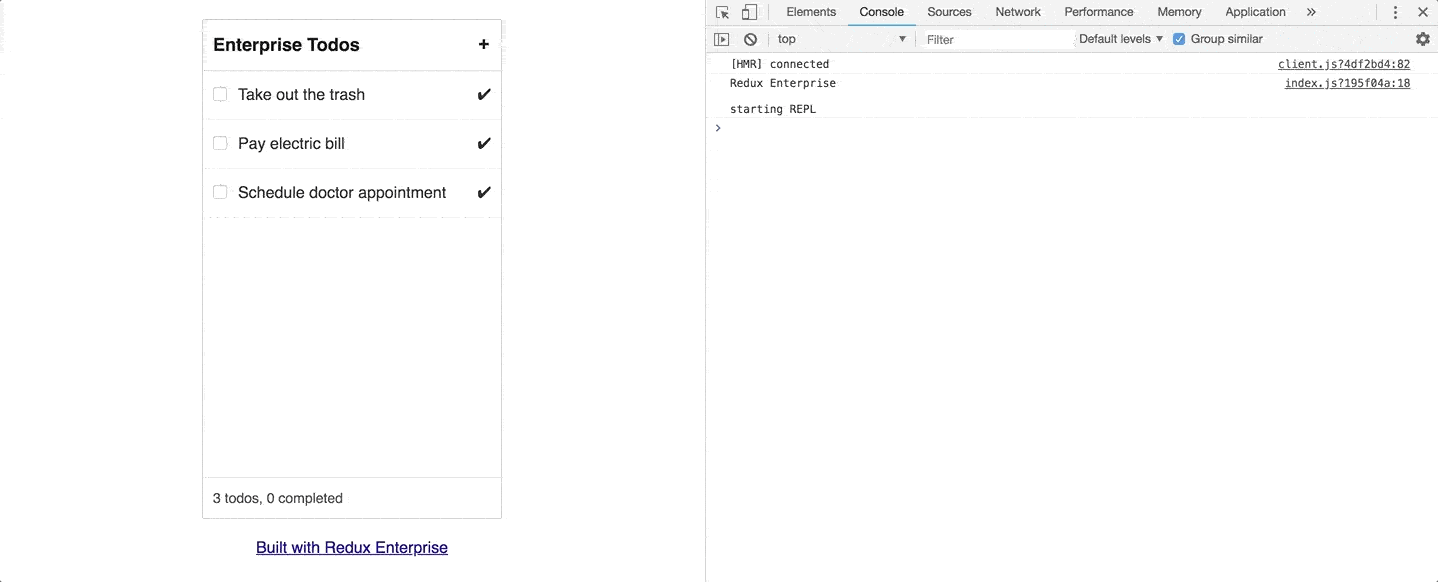
Redux Definitions
yarn add redux-definitionsTLDR - Define and share reusable slices of Redux.
Common reducer patterns always get recycled, write them once and then never repeat yourself again! Use definitions to automatically generate namespaced reducers, actions, and selectors for a predefined slice of functionality.
The example below implements the Redux code necessary for a basic shopping experience in 12 lines of code. This is achieved by leveraging an existing Collection definition and creating a custom Cart definition.
const Collection = Definitions const Cart = const actions reducers selectors = BONUS
Use the browser console to call actions and selectors against the running Redux application.

Table of Contents
Overview
Inspired by lessons learned building countless UIs, Redux Definitions is a library that abstracts common Redux reducer patterns into reusable definitions that can be shared and used to generate standardized and logically related actions, reducers, and selectors.
Redux Definitions is 100% compatible with any existing Redux-based project.
Objective
To help organizations scale development, maintainability, and velocity on Redux-based projects.
Whats included?
- Library of reusable reducer definitions (Flag, Field, Collection, Index, etc)
- Automatically generated actions, reducers, and selectors.
- In-browser Redux-REPL for interacting with running application.
Installation
yarn add redux-definitionsConcepts
createReducers
As shown above your core application state is described using a library of reducer definitions. createReducers takes these definitions and creates reducers for you with corresponding actions and selectors.
const Collection Flag Field Index = Definitions const actions reducers selectors = Each top-level key in the
createReducersschema generates a separate reducer.
Actions
Action creator functions are returned from createReducers calls as actions. The reducer definition determines what actions are available. For example a Collection has actions create, upsert, remove, set, reset, clear. Learn more about what actions are available and what their expected payloads look like the reducer definitions section.
const todoList todoEditor = actions todoListtodos// { type: 'todos/create', payload: { id: '1', message: 'Do thee laundry' } } todosListtodos// { type: 'todos/update', payload: { id: '1', message: 'Do the laundry' } } todoEditoreditingId// { type: 'todoEditor/editingId/set', payload: '1' } todoListtodos// { type: 'todos/remove', payload: '1' } todoListselectedIds// { type: 'selected/add', payload: '1' } } todoListselectedIdsclear// { type: 'selected/clear' }Selectors
Selectors are also returned from createReducers. For example a Collection has all, find, ids, and count:
const todoList todoEditor = selectors todoListtodosallstate // returns a collection of todostodoListtodos // returns a todo with matching `id`todoListtodosidsstate // returns an array of idsThese selectors are perfect for feeding into Reselect
Redux-REPL
When in dev-mode Redux Definitions automatically provides a REPL-like experience in the browser console for dispatching pre-bound actions and selectors. Actions and selectors from all createReducers calls are available in the REPL.

For your convenience unlike normal actions and selectors, calls to actions and selectors in the browser console are pre-bound to
store.dispatchandstore.getState. Remember, only in the console!
To setup the REPL, import startRepl and call it on your project's store object.
... const store = Note: when server-side rendering this call will be a no-op.
InitialState
All reducer definitions accept initialState values.
const Collection Flag Field = Definitions const reducers = Reducer Definitions
Redux Definitions provides an assortment of reducer definitions that can be found by importing the Definitions object. Reducer definitions aim to be low-level enough to be generic but high level enough to abstract state patterns common to all applications.
Field
Field creates a simple reducer that stores any value and comes with action types that set and clear.
Actions
set(payload: any)
Sets Field to payload value.
clear(void)
Clears current Field state.
Selectors
get(state: {}): any
Returns the Field state.
isSet(state: {}): boolean
Returns a boolean specifying whether a Field value is set.
Record
Record creates a reducer that stores an object. The object can be set or updated (similar to setState).
Actions
set(payload: {})
Sets Record state to payload object.
update(payload: {})
Merges payload object into the current Record state.
clear(void)
Clears Record and sets it to an empty object.
Selectors
get(state: {}, keys?: string|string[]): {}
Returns the Record object, optionally takes keys to return a subset of the Record.
keys(state: {}): string[]
Returns an array of the Record's existing key names.
Flag
Flag creates a reducer that stores a boolean value and comes with actions for setting and toggling.
Actions
set(payload?: boolean)
Sets Flag to true or to the optional payload's boolean value.
unset(void)
Sets Flag to false.
toggle(void)
Toggles Flag value.
Selectors
get(state: {}): boolean
Returns the current Flag value.
Collection
Collection creates a reducer that stores Entities. Entities are objects with id properties. Entities can take any form as long as they at least have an id.
Id = string
Entity = { id: Id }
Actions
set(payload: Entity[])
Takes an array of entities. Resets entire Collection to the payload of entities.
reset(void)
Resets the entire Collection to empty.
create(payload: Entity)
Takes an Entity and adds it to the Collection. Warning will be logged if an entity with the id already exists.
update(payload: Entity)
Takes an Entity and updates it in the Collection. Entity is not added unless an entity with the id already exist.
upsert(payload: Entity)
Takes an Entity and updates it in the Collection. The entity will be added if an entity with the id does not exist.
remove(payload: Id|Id[])
Takes an Id and removes any existing entity with the id.
Selectors
all(state: {}): Entity[]
Returns array of entities.
ids(state: {}): Id[]
Returns array of ids.
find(state: {}, params: { id: Id }): Entity
Returns entity that matches id parameter.
count(state: {}) => number
Returns the number of entities in the Collection.
get(state: {}) => Normalized
Returns the full underlying data structure which takes the form: { ids, entities } where ids is an array of unique id keys and entities is an id-based lookup map.of ids and entities.
Index
Index creates a reducer that stores a unique set of ids. Ids can be added, removed, and toggled. An Index is perfect for
Id = string
Actions
set(payload: Id[])
Takes an array of identifiers. Resets entire Index to the payload.
reset(void)
Resets entire Index to empty.
toggle(payload: Id)
Takes an identifier and toggles its presence in the Index.
add(payload: Id|Id[])
Takes an identifier(s) and ensures its presence in the Index.
remove(payload: Id|Id[])
Takes an identifier(s) and ensures its removal from the Index.
Selectors
get(state: {}): Ids[]
Returns the entire Index array.
includes(state: {}, { id: Id }): boolean
Takes id parameter and checks whether the identifier is present in the Index, returns boolean value.
count(state: {}) => number
Returns the number of Ids in the Index.
Custom Reducer Definitions
Create new reducer definitions with the createDefinition function. The resulting object is a valid definition that can be used.
const SpecialField = Usage
const reducers = Roadmap
- Full TypeScript support
- typed action and selector maps
- typed action and selector payloads
- Support for adding additional user created actions to the REPL
- Helpful for making existing actions/reducers accessible by the REPL
- createSagas helper for creating actions that initiate sagas and add actions to REPL
- Research how to best add async saga support within definitions
- Most asynchronous business logic will involve multiple reducers and therefore should not be associated with a single reducer or definition. Business logic should use createSagas and live in its own user defined directory/file. That being said the library should support adding basic asynchronous code to definitions.
Appendix
Typescript
Redux Definitions is written in TypeScript. Due to the generative nature of the library fully typed actions, reducers, and selectors have proven difficult to implement. The goal is to get to the point where all actions and reducers have fully typed payloads. ✨Contributions from anyone with ideas on how to achieve this are very appreciated! Feel free to open a Github issue or start a conversation on Spectrum with any thoughts or ideas.
Examples
- NextJS
- NextJS Typescript Help with this
- Create React App Help with this
- Create React App Typescript Help with this
PRs with other examples are appreciated!
FAQ
Coming soon!
Contributing
Please check out the Contributing page to learn how to get involved.



